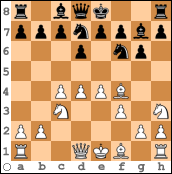
Position after 8.Nh3: Sort of a King's Indian Samisch. White plans on lining up a battery on the c1-h6 diagonal, castling kingside, and going for a kingside pawn storm attack.
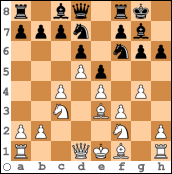
Position after 12...h6: Black would like to play 13...Nh7 and then prepare ...f7-f5 at some point to break in the center. However, this plan doesn't quite work in this position because 13.Qd2 forces 13...Kh7 to protect the h6 pawn.
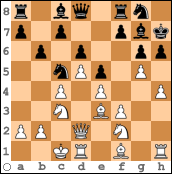
Position after 16...Ng8: White can't quite take on h6 yet, and Black threatens to play 17...h5 to close up the kingside. White finds the solution in 17.h5! preventing Black from shutting the door on White's kingside attack.
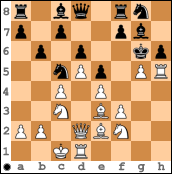
Position after 19.Be2!: Offering up the rook. The idea was to trade the rook for the opportunity to bring the rest of my pieces into the action. At this point, check out the sequence on the game replayer to see how I bring in the rest of my army to make the final assault on the king, most of the moves with tempo.
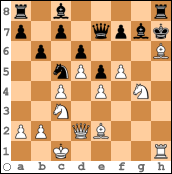
Position after 25...Rh8: Black resigned. White has many ways to win here. Perhaps the cleanest is 26.Bg5+ Kg8 27.Rxh8+ Kxh8 (or 27...Bxh8) 28.Bxe7 and White is way ahead.
Lessons from the game:
1. Typical plans in opening systems need to be checked for tactical soundness before being played "automatically" - e.g. Black's common King's Indian plan of ...h7-h6, ...Nh7, and ...f7-f5.
2. During a pawn storm against a castled position (such as in the KID Samisch, the Pirc 150 attack, or in some variations of the Sicilian Dragon for example), don't allow your opponent to lock up the pawns and "shut the door" on your attack.
3. During a direct attack on your opponent's king, it is worth material to gain time to bring in reinforcements to the attack.
I hope you enjoyed the game. I certainly enjoyed playing it. As always, feedback is welcome and appreciated.
Bryan,
ReplyDeleteExcellent game! 17. h5 was especially insightful, and 19. Be2 was bold (sacking a rook) and what the position called for.
Perhaps you could mention that the position contained the pre-conditions for a successful combination:
1. Black was poorly developed
2. Black would lose several tempi by Kxh5 - g6 - h7 while white continued to press forward
3. White's pieces had greater mobility and coordination than black's: only the Nc3 is not joining the party, while black's Nc5, Ra8, and Bc8 are out of sight, and the black queen's help is dubious because she allows other attackers to join with tempo (24. Ng4). Black's pieces are also poorly coordinated: the f pawn gets in the way, the Ng8 is in the way of the Rf8, etc.
Black did miss the critical defense: 22... Ne7 (rather than ...Nf6). What did you plan in response to 22... Ne7? Here's my analysis:
23. f6 Ng6 24. fxg7 Kxg7 25. gxh6 Kh7 and black survives.
23. f6 Ng6 24. fxg7 Kxg7 25. Rxh6 Rg8 and the black king exits via f8.
23. Rxh6+ Bxh6 24. gxh6 and white's h6 pawn actually provides shelter for the black monarch.
23. g6+ Kg8 and black again seems to survive.
I'm probably overlooking something strong, and probably white can still win it by bringing the knight and queen into the arena--but it will not be a quick knockout. In turn this means that black *might* find a drawing or even winning continuation that turns back the attack.
It is not surprising that black failed to find the strongest defense. A reasonably sound sac in an amateur game can throw the defender into panic and desperation. Kudos!
Chris,
ReplyDeleteI think I've come up with a solution to the problem...although it took me a little while and it was very instructive.
The full analysis is quite long, so here are some highlights:
After 22...Ne7!?
23.Ng4! I believe wins. For example, if 23...Rh8 (giving the king an escape square), then 24.gxh6 Kg8 (if 24...Bf8 25.Nf6#) 25.Bg5! f6 26.Nxf6+ Bxf6 27.Bxf6 Kf7 (trying to escape while keeping the rook protected) 28.Qg5 Rg8 (or 28...Qg8) 29.Bh5+! and black's going to get mated soon. Sorry about the long line, but it's necessary to show the moves.
Now, the other main defense that doesn't just give up material after 22...Ne7 23.Ng4 is 23...f6 trying to block up everything, but then 24.g6+ Kg8 (if 24...Kh8 then 25.Bxh6 wins) 25.Nxh6+ Bxh6 26.Bxh6 and Black will have to give up a lot of material just to keep from getting mated, for example 26...Nxg6 27.fxg6 Qe7 28.Bxf8 Qxf8 29.Rh7 (the queen is stuck protecting h6 against the White queen's entry and White can just play his bishop on e2 out of the way of the 2nd rank and the queen can enter that way).
Now, I'm afraid to turn Fritz on because I did this all by hand. I'll probably check it over later and hopefully some of it is sound. Thank you for your analysis and inspiring a 45 long analysis session!
Bryan - Good analysis, I enjoyed it. This position would make for a terrific Stoyko exercise, no question about it. (See http://danheisman.home.comcast.net/~danheisman/Articles/Exercises.html .)
ReplyDeleteAs black I would most strongly consider 22... Ne7 23. Ng4 Nxf5!? 24. exf5 Bxf5 to try to sap some of the strength from white's attack. As white is down a rook, sacking a knight for 2 pawns and a *little* defensive breathing room makes a lot of sense. Not sure it would work, but it's certainly worth analyzing.
I would still prefer white, but it the situation is not completely clear yet after the counter-sac...as far as I can tell with 10 minutes of analysis.
ReplyDeleteDefinitely an interesting positions. With a short time control, I was partly running on instinct, partly trying to calculate as much as possible. My analysis shows that it was fairly sound, although of course who knows what would have happened if Black had a stronger defense.
ReplyDelete